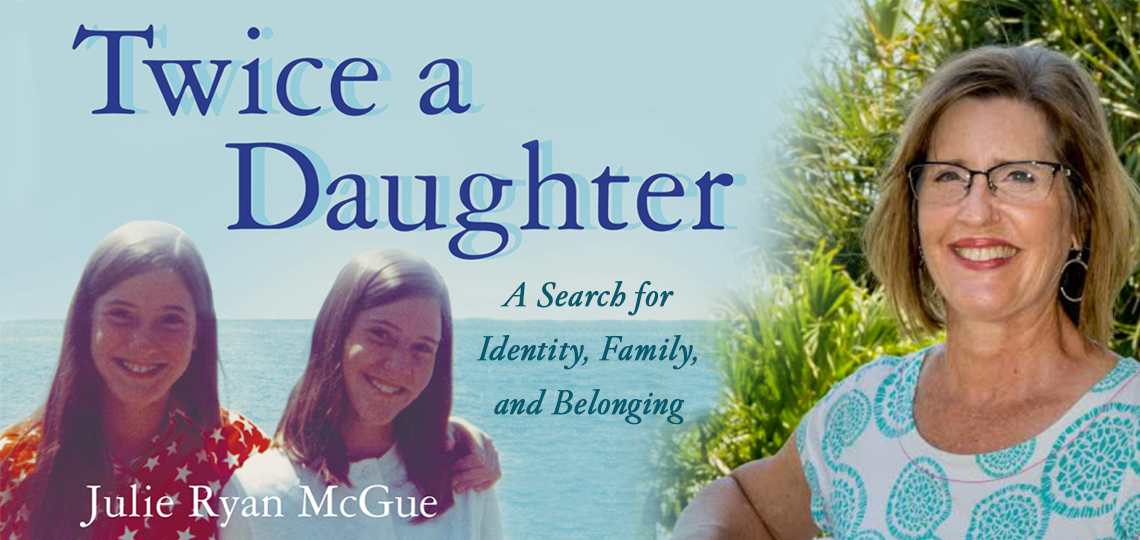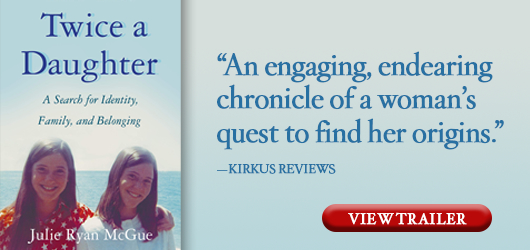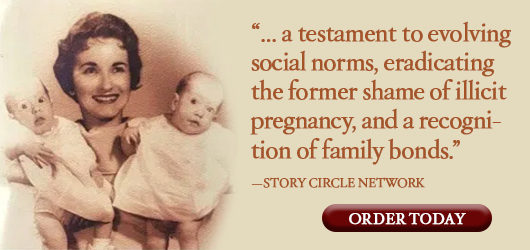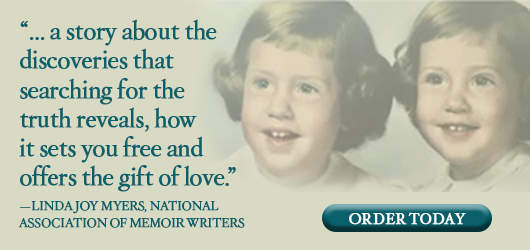What would it be like to grow up without a sense of who you are or where you came from?

Interview with Julie Ryan McGue, Author of Twice a Daughter: A Search for Identity, Family, and Belonging
The majority of us who left the hospital with our parents at birth and stayed with them through thick and thin into young adulthood, don’t seem to appreciate how fortuitous that experience is to our sense of self. Imagine, as many adoptees do, not knowing the woman and man who made you. Imagine wondering why your eyes are green and your hair black and curly. We all inherited innumerable traits from our ancestors and it’s only human to want to know who they are.
You’re about to hear from a woman who had to wait more than fifty years to solve the puzzle of her origins. A twin, Julie Ryan McGue and her sister were adopted at just a couple weeks old by a loving Chicago couple. And while she had many questions about her birth parents over the years, it wasn’t until she faced a health scare at forty eight that she began what turned out to be an arduous search process—detailed in her new book, Twice a Daughter: A Search for Identity, Family, and Belonging.
Julie was gracious enough to answer the following questions about her adoption journey and the compelling reasons that led her to write the book.
When did you decide you wanted to search for your birth relatives? What kept you from searching earlier in your life?
My twin sister and I grew up in a big, Irish Catholic family in the suburbs of Chicago. In one sense, we are a blended family—the older three of us were adopted through Catholic Charities, and the three youngest are my adoptive parents’ biological children. My parents doled out praise and love equally; I never had the sense that they played favorites. I have wonderful memories of quality family time: hours spent playing puzzles and games, drive-in movie nights, and week-long vacations spent at the family cottage in Michigan.
My parents must have told my twin sister and me about our adoption at an early age—I seemed always to have known. Even though we were curious about our family of origin, we didn’t want to hurt our parents’ by expressing an interest in our birth parents. It was a psychological balancing act: satisfy a desire to know your full identity or risk hurting those you loved and who cared for you. Added to that dilemma was the knowledge that our “closed adoption” meant that our personal history was sealed, legally forbidden to be shared with anyone. Given all these factors, we did what many adoptees do. We suppressed our curiosities, our need to know more, and we assumed the ethnic and cultural identities of our adoptive family.
Because of my involvement with a post-adoption support group at Catholic Charities, I learned that fear—fear of hurting the adoptive family and risking more rejection—are common reasons why adoptees delay searching or choose not to search at all. Some adoptees delay launching an adoption search until their adoptive parents are deceased. Still others halt searches mid-stream to stem the pain of repeated disappointments, dismissals, and more loss or rejections.
Adoption search and reunion is not for the faint of heart. An adoptee must have a strong support system before tackling such a demanding project, one with very uncertain outcomes. While adoptees long for answers regarding identity, family health history, and genealogy, it’s the fear of damaging important familial relationships that holds us back. The other factor is timing. An adoptee should be in a good place with respect to marriage and family, career path and financial stability before tackling the daunting uncertainty of an adoption search.
Given all that I’ve laid out, it’s not surprising that I waited until I was thirty years old—and without my parents’ knowledge—to send a letter to Catholic Charities requesting information about my adoption. By this time, I was a mother of three, and my curiosity had blossomed into something more. I felt a responsibility to my children to offer them more about their own family history. Several weeks after mailing my request, I received a form letter from Catholic Charities: Nothing can be shared at this time. Eighteen years passed before a breast biopsy compelled me to launch a second search effort which is the story detailed in Twice a Daughter. And by this time, the Illinois adoption statutes underwent an overhaul.
What were some of the emotional steps you took to prepare yourself to write Twice A Daughter: A Search for Identity, Family, and Belonging?
When I was sent for a breast biopsy in 2008, I was forty eight. This event highlighted to my twin sister and me that it was time to get serious again about accessing our family history. My sister and I agreed that we would first discuss the adoption search with our parents. Garnering their support, as well as collecting our adoption papers from them, were vital steps.
As mentioned, my twin sister and I grew up in a nurturing household. During our childhood, Mom had often professed that she and Dad would support a search when and if we felt inclined. Yet, when I did finally present my need to connect with our birth parents, my adoptive mother froze-up. Here I was a middle-aged woman with a health issue, and her lack of support baffled me. A rift developed between us, and as a result, my sense of belonging and family were threatened.
Concurrent with the faltering relationship with my adoptive mom, the initial outreaches with birth relatives did not go well. These disappointments and rejections affected how I came to view myself. I felt vulnerable. On top of my tattered sense of belonging, I now struggled with issues related to identity and self-worth. My world became a very shaky place. “Unmoored” is a good word.
During this uncertainty, I picked up every adoption book I could get my hands on. Ann Fessler’s work, The Girls That Went Away, profoundly impacted me. It caused me to realize that for most of my life I’d suppressed my feelings about being adopted and ignored my need for identity and personal history. As a middle-aged woman with questionable health, the adoption search caused me to “come out of the fog.” I became a fierce advocate for open records and an adoptee’s “right to know.”
As I navigated each phase of my search, I relied on the unflinching support of my twin sister, my husband, family, and many friends. As much as I trusted this core group to boost my morale, the impact of my birth relatives’ negative responses weighed on me. I sought counsel from a Catholic Charities social worker. She invited me to join a support group comprised of adoptees, their significant others, birth parents, and a few adoptive parents. The group meetings afforded us the space in which to share our adoption experiences, to commiserate about stalled search and reunions, and to applaud the many success stories of our tribe. Finding this support was a backstop. As a result, I no longer felt that my sister and I were on our own as we grappled with indecision, conflict, and profound rejection. The group also offered me the tools which paved the way to acceptance, forgiveness, and healing.
Throughout the five years of my adoption search and reunion journey, I continued my lifelong commitment to journaling. From these pages I crafted the first draft of my memoir. Unfortunately, this effort was an angry narrative and very one-sided. Not publishable. I enrolled in writing courses at the University of Chicago, followed by a virtual, memoir-in-six-month course with Linda Joy Myers (NAMW) & Brooke Warner (She Writes Press). As a result of this coursework, I completed a solid first draft. During Covid, I hired Linda Joy as my editor, and we completed the final revisions prior to publication.
Without a doubt the commitment to journaling, familial support, strong marriage, and tight bond with my twin sister helped me navigate the lengthy and rigorous path of adoption search and reunion. But I credit my deeper understanding of the adoption triangle: birth parents, adoptees, and adoptive parents to the post-adoption support group and to the adoption literature I devoured. These factors and supportive relationships influenced the final version of Twice a Daughter.
Twice a Daughter is about you and your sister navigating an adoption search, your bond with her, and the many things you discover. Who is who on the cover, and how did your twin sister feel about your writing this memoir?
On the book cover, my sister is on the left in the red-and-white shirt, and I’m on the right. Because she and I have always looked alike, very early on my mother got in the habit of placing me on the right in family photos. This picture was chosen for the cover because it is integral to the plot twists that take place in the final pages of the story. It was taken on the shores of Lake Michigan in Palisades Park, Michigan, during a family vacation. Fast forward forty years and the family cottage became an unexpected and crucial link to my family of origin.
The fact that I am a twin, who was adopted and raised with her sister, is a unique twist on being adopted. Besides desiring knowledge about family background and birth circumstances, adoptees want to know who they look like and if they share traits and characteristics with family members. I didn’t need to look very far to see a family member who resembled me. Being adopted with my twin removed some of the mystery of the adoption experience for us.
In my relationship with my sister, we often switch roles. It is a “passenger-driver” situation. Often, my sister is at the wheel steering the course of our lives, and other times she lets me take the lead. Sometimes we do this consciously, like in the case of our adoption search, but there are moments when the switch is unconscious, driven by who feels stronger about whatever situation arises. I’m forever grateful to Catholic Charities for implementing a policy that does not separate children from a multiple birth.
With respect to writing the book, I informed my sister early on that it was my desire to tell our story. Without hesitation, she gave me her support. When the ARCs came out in January 2021, she received the first copy. By March, I quizzed her as to why she still hadn’t read it. She laughed, “I know how the story comes out.” This response speaks volumes about our relationship. She trusts me. She knows that I will always honor her and handle our lifelong bond with care and respect. I have her back and she has mine. That could be the subtitle of our sixty-plus years together.
Did you have a target reader in mind when you crafted your memoir?
My target reader is anyone who has been touched by the adoption experience: the adoptee, the adoptive parent, the birth parent, extended birth family, and the siblings in an adoptive family, as well as any reader who is interested in learning more about the adoption experience.
In my search journey, social workers were the in-the-trenches heroes. They made a profound difference in the outcome of my search and impacted my state-of-mind by the compassionate support they offered. As a way of giving back, I’m committed to offering any social worker who contacts me through my website, a free signed copy.
What do you hope readers will gain from reading Twice a Daughter?
Each member of the adoption triangle has a unique perspective that must be heard and appreciated. I wanted to convey the nuances of each position: the possessiveness of adoptive parents; the innate rights of birth parents to maintain their privacy or to achieve connection to their biological child; and to advocate for the adoptee’s inherent right to all information that concerns them.
Adoption is complicated. Inherent in the adoption experience is great joy and deep loss or trauma. An adoptee and his/her adoptive parents gain family, something that both parties need. Often the adoptive parents experience infertility, and adoption becomes the only vehicle to start a family. Because of the inability to conceive, the adoptive parents lose the option to parent their own biological child. Adoptees like me from the closed adoption era lost their connection to their family of origin, as well as a sense of who they are and where they come from. Similarly, birth parents lose their chance to parent their biological child.
I want the reader to grasp the magnitude of adoption’s veiled losses. And if the reader has not been touched by adoption, I ask them not to judge any of the players. An adoptee who chooses to search for their background is not selfish and is not turning away from their adoptive family; rather, he/she is choosing to know themselves better. A birth parent is not a bad person for placing their child for adoption. Adoptive parents that have experienced infertility are not less than those that are able to raise their own biological children.
Adoption is a universal experience. It transcends race, class, ethnicity, and geography. The adoption story is one shared by parents and children across the globe. While my book is about my search for identity, family, and belonging, it is every adoptee’s story about the search for self. While the specific circumstances of the adoption experience may differ, every adoptee feels the inherent loss in adoption.
On one hand, Twice a Daughter is a how-to guide listing the steps that an adoptee might implement in seeking their personal story, but it is also a set of instructions of what-not-to-do. When my sister and I set out on our journey ten years ago, we were rookies. We didn’t know anyone who had found their birth family, and we didn’t have a clue how to get started. In 2010, genetic genealogy was in its infancy, and not effective in providing answers in our case. Today, DNA sites offer better results in connecting adoptees with family members.
My confidential intermediary told me that 95 percent of adoption searches end up in contact, but I was on shaky ground throughout both of my searches. I guess you can say, I succeeded despite being the worst-case scenario. I never gave up. I threw everything I could at the task: a search agency, my adoption agency, a PI, a confidential intermediary, a judge, and a genealogist. I needed all these people to help reveal the secrets of my story.
I hope that readers will be interested in my journey of overcoming adversity, and that adoptees will benefit from all the information I provide.
How do you see or understand yourself differently after the success of your search for birth relatives?
Perseverance and resilience were qualities that I possessed before the search, but the degree to which I needed to test and further develop these virtues dumbfounded me. Normally a reserved, serious person, the range of emotions that the search elicited was often exhausting. In one day, I might cycle through anger and then joy, denial and then resignation, disappointment and then forgiveness.
I look back on this tumultuous period of my life and reflect on how it was that I made it to the other side. I didn’t realize that I had the capacity to accept so much disappointment, that I could forgive so many grievous wrongs, and that I could experience so much contentment and satisfaction.
What recommendations do you have for other adult adoptees contemplating a similar search for birth relatives?
Adoptees need to know that adoption search and reunion is hard work. You cannot predict how it will go, because you do not know the players or their circumstances.
Be prepared: read, research, talk to people, and line up contingency plans. Make sure you are in a good place regarding your finances, relationships, job, and family life. Know that you will be disappointed, rejected, surprised, lifted and rewarded.
When considering adoption search and reunion, having a meaningful and effective support system in place is essential for navigating the process. Participating in post-adoption support helped me to accept and forgive what I could not change, and it gave me the tools to maintain and foster new and complicated relationships. Not all adoptees feel the same about their adoption experience. Some choose not to search, to delay their search, or to avoid thinking about or discussing their adoption. Neither choice is right nor wrong. Whatever choice is made is the right one for that person.
Letitia Montgomery-Rodgers



